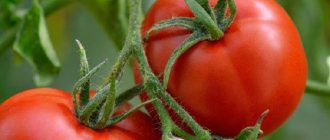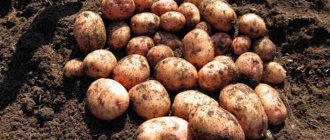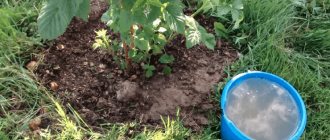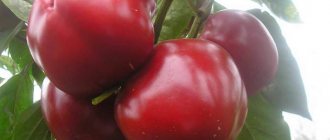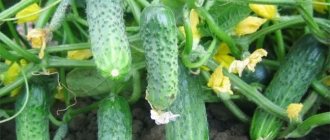Why fertilize potatoes?
Potatoes, like tomatoes, are vegetables of the same family, Solanaceae. In science, the crop is called tuberous nightshade (Solanum tuberosum) - a herbaceous tuberous perennial.
Reference. We owe the appearance of “earth apples” in Russia to Peter I. The Russian Tsar brought a bag of tubers from Holland at the end of the 17th century. Gradually, by the mid-19th century, the root vegetable literally became the second bread.
Due to the “kinship”, the requirements of potatoes for basic nutrition and seasonal feeding are very similar to those for fertilizing tomato seedlings. But still, some features of growing, planting and care exist.
Let us dwell in more detail on the important factors and features of seasonal fertilizing that directly affect the full ripening of a high-quality and rich harvest.
Factors affecting yield
Let us highlight the mandatory procedures that directly affect high potato yields:
- pre-sowing soil nutrition with nitrogen, phosphorus and potassium (autumn or spring);
- preparation of planting material (processing of tubers before planting);
- nutritional mineral supplements before and after potato flowering;
- pre-harvest desiccation (drying of tops);
- preventive feeding (adding a complex of microelements and fungicides).
Fertilizing the soil before planting potatoes
Do I need to feed potatoes? Everyone's favorite root vegetable forms, grows and ripens in the soil. Naturally, without enhanced nutrition it will not be possible to dig up a “treasure” in the form of a luxurious harvest.
Everyone knows that it is necessary to fertilize the soil before planting tubers. It is also important not to skip fertilizing during growth periods that are critical for the crop.
What fertilizers to apply in the fall for digging?
It is important to prepare the soil for planting potatoes in the fall. During autumn plowing, dolomite flour as a deoxidizing agent. Potatoes prefer neutral to slightly acidic soil.
Fertilizing the soil for potatoes with organic matter - manure, humus, compost, wood ash - will enrich the fertile layer in the root system zone.
Before winter, the best fertilizer for potatoes will be sowing green manure:
- until mid-September - mustard, rapeseed;
- until the beginning of October - winter rye.
Important! Mustard is sown in temperate climates and cold regions. Rapeseed does not like moisture and cold very much, it does not tolerate night temperature changes well, it is sown in the southern regions.
Green fertilizers ensure the exchange of beneficial microflora and improve soil fertility by 2-3 times. Pre-winter planting of green manure after potatoes replenishes the supply of nutrients and promotes natural loosening of the soil.
Mineral fertilizers : ammophos, diammophos, calcium nitrate - applied in the fall. Feature - phosphorus serves as a reserve; gradually until spring the nutrient element will dissolve and become available to plants. The granules are buried by 10-12 cm when digging the area.
Preparing soil for potatoes
In addition to basic soil nutrition with nitrogen, phosphorus, potassium and a complex of microelements, care must be taken to disinfect the soil.
To save the crop from diseases and garden pests, the area must be treated with special disinfectant preparations:
- Entocide;
- Boverin;
- Metarizin;
- Verticillin.
Modern safe disinfectants solve the problem of healthy biologically active soil, resist the appearance of mole crickets, chafer larvae, wireworms, and wintering Colorado potato beetles.
How to fertilize potatoes when planting? Directly when planting seed tubers, organic or mineral fertilizers are added to each hole:
- microbiological fertilizers (for example, Baikal);
- compost, Bokashi, rotted manure, bird droppings, humus;
- urea, saltpeter, superphosphate, potassium sulfate (in equal parts, 15-20 g each).
Attention! If the soil is fertile and abundant fertilizing was carried out in the fall, then it is not necessary to add fertilizer to the hole.
Preparing tubers before planting in a hole
Experienced farmers claim that pre-sowing spring soil preparation for planting potatoes is best done 3-4 weeks before planting tubers in order to start the processes of enriching and structuring the soil.
You need to prepare the seed for planting in advance.
Mandatory conditions for preparing seed potatoes for planting in the spring :
- “Like the seed, like the tribe ,” people say. Following folk wisdom, only large, smooth, even, undamaged tubers are selected for planting. Underdeveloped small potatoes will not produce a good harvest. A tuber of irregular shape (in the form of a figurine, heart, etc.) is a sign of degeneration of the crop and is not suitable for planting. Plants from such tubers will become sources of viral infections.
- Store tubers for planting in cool rooms ; low temperatures protect against premature growth of sprouts. The tuber itself retains all nutrients, starch, and sugar until spring. Nutrient elements will ensure uniform development and growth of the future crop.
- Warming up the tubers is a must for small summer cottages and large farms. 3-4 weeks before planting, seed potatoes are transferred to a bright, warm place and scattered on the floor in one layer.
- in the light . The synthesis of green pigment and the plant poisonous glycoside solanine protects seed material from damage by soil insects in the early stages of growth.
- To plant, the sprout should stretch 2-3 cm, no more, while the tubers are warming up. Too long sprouts break off when covered with soil, and the development of tuber germination will be delayed.
Why is it so important to prepare the soil in the fall?
If potatoes are planted year after year in the same place, and so on for 10-20 years in a row. What a big harvest we can talk about. In just one growing season, the bush consumes 100 g of potassium, 30 g of phosphorus and 60 g of nitrogen. Some of the useful minerals attract weeds, while some in dissolved form go into deeper layers. When planting a crop, even if there is a shortage of space, you need to remember about soil fatigue.
To do this, you can do crop rotation, fertilize, and sow green manure. The main success of a good harvest is to prepare the land. It is better to do this in advance - in the fall. It is important to give the soil in advance what the potatoes consume for their growth and tuber formation.
Spring feeding of potatoes
An excess of organic and inorganic substances also negatively affects the yield, as does a deficiency of elements.
Organic matter (manure, litter) contains concentrated doses of nitrogen. It is dangerous to apply fresh; you can burn the entire immature root system. Bird droppings and manure are diluted with water in a ratio of 1:15.
For heavy clay and infertile soil, the average rate of manure application is 140-200 kg per hundred square meters. For fertile soil, 70-80 kg is enough.
Mineral complexes and fertilizers (ammophos, saltpeter, superphosphate, urea, etc.) in granular form are scattered over the site and embedded in the soil during digging. Liquid solutions are prepared according to the instructions - no more than 20-35 g per 10 liters.
Acceptable micronutrient supplements:
- HOM (copper oxychloride) – 30-35 g per garden bucket (up to 12 l); processing of the aerial part of the leaf is carried out early in the morning.
- Mag-Bor is diluted in the ratio of 20-25 g of the drug per 10 liters of water; The bushes are sprayed with the working solution. The same dosage (25 g per 1 sq. m) is used to fertilize the soil for digging.
- Potassium humate, preparations Vympel and Vympel-2 (30% potassium humate). The liquid form is convenient for diluting the solution for sprinkling - 1 measuring cap per 3-5 liters of water.
How to feed potatoes before hilling?
The first hilling is carried out when the bushes are about fifteen to twenty centimeters high.
In total, potatoes are usually hilled twice a season. This is done to protect against return frosts, drought and weeds. Hilling helps to better retain moisture around the tubers, which means it increases the quantity and quality of the harvest. To fertilize potatoes before hilling, it is better to use complex compounds with the obligatory inclusion of nitrogen:
- Azofoska,
- urea (carbamide),
- superphosphate (can be applied together with cow manure),
- chicken manure (diluted with water in a ratio of 1:10),
- feeding with ash.
What fertilizers are strictly forbidden to apply to potatoes in the fall?
In autumn, it is prohibited to fertilize the soil for potatoes with nitrogen fertilizers. Nitrogen can cause plant growth, and it also decomposes quickly and is poorly retained in the soil. Before the crop is planted, the nutrients will evaporate and be washed away by rain and snow. Therefore, such fertilizers should be used in the spring. The exception is urea.
There is an opinion that applying fresh manure in the fall is not recommended, since the weeds that fall into it may begin to germinate, and if it does not have time to “ripen,” the tubers may turn out tasteless and watery.
Feeding potatoes after flowering
If summer residents visit the site intermittently and are a little late, then within 2-3 weeks after the potatoes bloom, fertilizing with calcium nitrate will also be effective and efficient. The main thing is to “feed” the soil microbiotics and support young seedlings at the very beginning of vegetative growth.
In addition to applying basic fertilizers and means of protection against diseases and pests before and after flowering, it is important to treat potato bushes in July-August.
Gradually, the nights become cool, it rains in some regions, and the humidity of the air and soil increases. As the weather gets colder, the risk of bacterial, fungal and viral infections increases.
Optimal types of late-season potato fertilizers:
- To prevent chlorosis and accelerate the full ripening of tubers, magnesium and boron are needed. Fertilizers are used in liquid and granular form. The domestic drug Mag-Bor contains more than 15% magnesium. Timely feeding will protect plants from premature aging (yellowing and wilting of the vegetative aerial parts).
- Fertilizing with manganese and copper will save potato tops from heat and drought The contact fungicide HOM (copper chloride) has proven itself well. The inexpensive drug will eliminate the deficiency of essential microelements and protect against scab, fusarium, and late blight.
- Potassium humate is a natural anti-stress drug that contains humic salts, organic acids, and a complex of microelements. Neutralizes the effects of pesticides, heavy metal salts and radionuclides. Farmers recommend Humate + 7 iodine. The drug is easily soluble in water and is used to prevent rot and scab.
- To prevent pests (cutworm, wireworm, scale insects, mole cricket, Colorado potato beetle), it is important to treat the bushes with special preparations - Confidor Extra, Kinmiks.
Preparing organic trenches for potatoes
Natural farming methods have never failed anyone. Potatoes love a thick layer of humus. And the best option to provide the plant with the necessary conditions is to plant the tubers in organic trenches. You need to start preparing them in the fall.
To do this, trenches are dug 40 cm deep and 60 cm wide. Organic waste is placed at the bottom. For better decomposition and enrichment with soil bacteria, they are shed with Siyanie-3. Organic matter has time to decompose within a few months. And for potatoes in the spring there is a delicious, delicious bed ready.
Pre-harvest desiccation (treatment) of bushes
Reference . Desiccation is the pre-harvest drying (dehydration) of plants to accelerate the full ripening of the crop.
Preparing potatoes for digging is easy. Some gardeners simply mow down the tops. A more convenient way is desiccation of the aerial part.
Pre-harvest treatment of potatoes with desiccant solutions is carried out for the purpose of:
- destruction of pathogens that cause diseases (late blight, fusarium, etc.); the infection first appears on leaves, stems, and gradually spreads to tubers;
- redistribution of nutrients; nutrients accumulated in the vegetative parts flow into the tubers; Root crops increase in size, are replenished with useful substances, and the taste of the crop increases.
The procedure is simple, carried out 2-3 weeks before harvest.
At home, prepare a concentrated solution for spraying potatoes before harvesting.
1 option
- 1 kg double superphosphate;
- pour 5-6 liters of boiling water;
- stir, put in a dark place for a day;
- strain, filter;
- Treat the bushes with the prepared mixture through a spray bottle;
- within a week the tops are completely dry.
Important: undissolved sediment is buried under berry bushes (currants, gooseberries) to replenish the soil with phosphorus and calcium.
Option 2
- 500 g of iron sulfate;
- 1 liter jar of urea;
- mix ingredients;
- dissolve in 9-10 liters of warm water;
- Spray the above-ground part with the mixture once;
- the tops will burn in 5-6 days.
The benefits of protective treatment of potatoes with a concentrated solution of urea and ferrous sulfate:
- completely destroys (burns out) pathogens located on the surface of the tops and soil; elimination of insect larvae (aphids, wireworms, Colorado potato beetles);
- the remaining disinfected leaves and stems are used as a layer for compost;
- the tops can be left in the beds and the area can be dug up before winter; the soil will be enriched with iron and nitrogen.
The best fertilizers for potatoes
Fertilizers are conventionally divided into mineral, organic (natural base) and complex (specially developed formula for the ratio of elements, according to the needs of the crop).
Mineral
Basic mineral fertilizers for potatoes:
- Calcium nitrate (calcium nitrate) is an alkaline fertilizer containing completely soluble calcium and phosphorus (up to 9%), nitrogen (more than 25%). Calcium ensures the absorption of nitrate nitrogen. Fertilizing stimulates tuber growth and rooting.
- Ammophoska is a basic NPK complex, containing more than 9% nitrogen, up to 20% phosphorus and 15% potassium. Feature – does not contain chlorine, the components are present in ammonium form. Autumn application of fertilizers to the soil and scheduled fertilizing give a start to the growth processes of tubers and contribute to the growth of the bush. The granules are used as an accelerator additive for preparing compost.
- Potassium sulfate (potassium sulfate) is a multifunctional potash fertilizer (more than 50% potassium in the composition), applied throughout the season, suitable for all types of soil. Completely absorbed by chlorophobic crops (tomatoes, potatoes, peppers). Ensures uniform development of tubers. It is considered an anti-stress drug due to the presence of sulfur (more than 15%), increases resistance to temperature changes, summer drought, and resists fungal infections.
Rules for combining different fertilizers in the fall
In the fall, to achieve a good result, it is important to correctly combine the types of fertilizing. There are several basic rules to follow:
- It is better not to combine dolomite flour, lime and chalk with mineral fertilizers, since phosphorus may not dissolve. Superphosphate requires a slightly acidic environment to dissolve; it does not work in an alkaline environment.
- Liming is not carried out together with fertilization with ash, since the latter contains enough calcium, which makes it possible to normalize the acidity level.
- Nitrogen fertilizers destroy all the beneficial properties of ash, so they cannot be applied together.
- Phosphorite flour in combination with manure will help phosphorus to better transfer and be absorbed into the soil.
- It is strictly forbidden to add urea and superphosphate at the same time.
Expert secrets for increasing your harvest
- The Dutch planting method saves up to 25% of the harvest even in small areas. The scheme is simple - the distance between holes in a row is 20-25 cm. The distance between rows is at least 80 cm. When loosening, wide paths protect the integrity of the root space (this zone is not trampled).
- Radishes are sown along one edge of the row with tubers, and peas on the other . Radishes, like all Cruciferous green manures, disinfect the soil, and peas enhance the productivity of potatoes.
- You can hill up young bushes only in the early morning or late evening . Hot, heated soil under the sun injures green shoots. The tops will turn yellow and stop growing. Green stems can withstand temperatures up to 45-50 C. Moreover, sprouts need to be spudded once when they grow to 12-15 cm. Next, you just need to loosen the soil.
